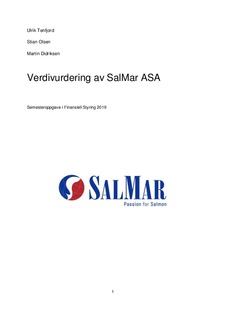| dc.contributor.advisor | Becker, Denis | |
| dc.contributor.author | Tenfjord, Ulrik Slinning | |
| dc.contributor.author | Olsen, Stian | |
| dc.contributor.author | Didriksen, Martin | |
| dc.date.accessioned | 2019-06-17T14:01:07Z | |
| dc.date.available | 2019-06-17T14:01:07Z | |
| dc.date.issued | 2019 | |
| dc.identifier.uri | http://hdl.handle.net/11250/2601110 | |
| dc.description.abstract | Formålet med denne oppgaven var å foreta en verdsettelse av SalMar ASA. Vi har valgt følgende problemstilling:
Hva er SalMar ASA verdt?
Innledningsvis i denne oppgaven har vi foretatt en beskrivelse av SalMar, med historie og status i dag, etterfulgt av en generell beskrivelse av selve oppdrettsbransjen. Videre har vi gjennomført en strategisk analyse hvor vi startet med en intern analyse ved hjelp av en VRIO-analyse, for så å gjøre en ekstern analyse ved PESTEL-analyse og Porters bransjeanalyse som henholdsvis tar for seg makro og mikroomgivelsene. Som avslutning på den strategiske analysen foretok vi en SWOT-analyse for å oppsummere våre funn. Kort oppsummert sier den strategiske-analysen at SalMar har vesentlige stordriftsfordeler, et voldsomt fokus på innovative løsninger, og at disse ressursene er lett imiterbare i framtiden. Det kommer også fram at det jobbes for å øke konsumet av sjømat både i Norge og på verdensbasis, noe som kan gi en generell positiv effekt for bransjen.
Videre har vi gjennomført en regnskapsanalyse basert på nøkkeltall beregnet av historiske regnskapstall. Analysen viser at SalMar stort sett har hatt en kontinuerlig positiv utvikling de seneste årene, hvor de fleste nøkkeltall har pekt i positiv retning, med en jevnt over god soliditet.
Som avslutning på oppgaven gjennomførte vi en finansiell analyse for å verdsette selskapet. Metodene vi brukte for verdsettelsen var dividendemodellen, DCF-metoden og multippel-analyse. Disse metodene ga hver sin pris på aksjen, og vi valgte derfor å vekte disse etter hva vi festet mest lit til, med henholdsvis 50% på DCF-metoden og 25% på de to andre. Resultatet av dividendemodellen var en pris pr. aksje på 446,60 kroner, mens resultatet av DCF-metoden og multippel-analysen ble henholdsvis 374,37 kroner og 315,86 kroner. Det var altså relativt store forskjeller på resultatene, men dette kan skyldes ulik grad av kompleksitet ved modellene. Totalt fikk vi en aksjekurs på 377,8 kroner, og konkluderer altså med at SalMar er overpriset i dagens marked. | |
| dc.description.abstract | The purpose of this report task was to make a valuation of SalMar ASA. We have chosen the following issue:
What is SalMar ASA worth?
Initially in this task we have made a description of SalMar, with history and status today, followed by a general description of the actual aquaculture industry. Furthermore, we have done a strategic analysis where we started with an internal analysis using the VRIO-model, followed by an external analysis with PESTEL and Porter’s five forces, that relate to macro and micro perspectives. To conclude the strategic analysis, we did a SWOT-analysis to summarize our findings. Short summarized, the strategic analysis of SalMar says that they have significantly benefits of high production and a strong focus on innovative solutions, but these resources are easily imitable by their competitors in the future. Also, there are a lot of campaigns to increase the consumption of seafood both in Norway and worldwide, which can give a general positive effect for the industry.
Furthermore, we have an accounting analysis based on key figures calculated from historical figures. Analyzes show that SalMar largely has a continuous positive development in recent years, where most key figures have gone in the right direction, with a steady solvency.
As a conclusion to the rapport, we conducted a financial analysis to value the company. The methods we used for valuation were; the dividend model, the DCF-method (discounted free cash flow) and a multiple analysis. These methods gave different prices on the stock, and we chose therefore to weight these according to what we thought were the most accurate, with 50% respectively on the DCF-method and 25% on the others. The result of the dividend model was a price per share of 446.6, while the results of the DCF-method and multiple analysis gave us a price per share of NOK 374.37 and NOK 315.86. There were relatively large differences in the results, but this may be due to different degrees of complexity of the models. As a result of our weights, we got a share price of NOK 377.8, and based on this we concluded that SalMar is overpriced in today's market. | |
| dc.language | nob | |
| dc.publisher | NTNU | |
| dc.title | Verdivurdering av SalMar ASA | |
| dc.type | Bachelor thesis | |
